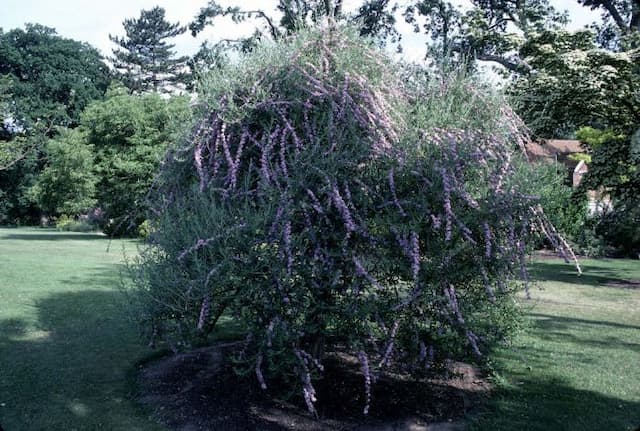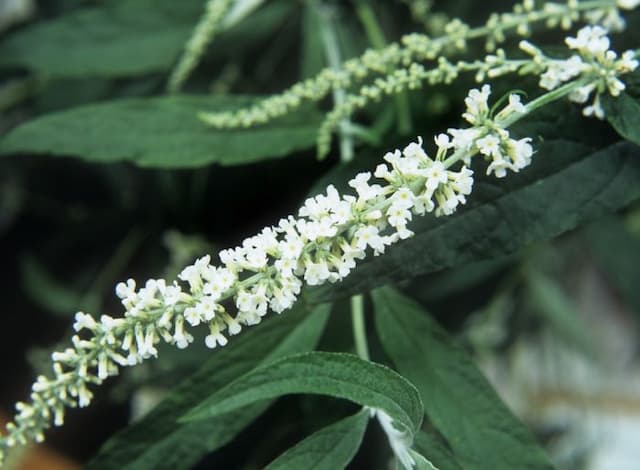South African Sagewood Buddleja salviifolia

ABOUT
Commonly known as the South African sagewood, this plant exhibits a lush and rounded shrub-like appearance. Characterized by its dense foliage, the leaves are a gray-green hue, resembling that of sage leaves, which likely influences its common name. Each leaf is textured with soft hairs and has a wrinkled, veiny appearance that adds to its visual interest. The sagewood's most distinguishing feature is its prolific blooming habit. It produces clusters of small, tubular flowers that come together in large, conical arrangements, exuding a sweet fragrance that is particularly attractive to butterflies and other pollinators. The flowers themselves are usually purple to mauve, with some varieties showcasing a white or pale lilac color. This plant has a woody stem structure that supports its branching habit, with the branches often draped with the weight of the flowers and leaves, lending to its overall graceful aesthetic. Even without going into specific dimensions, it is clear that the South African sagewood's appearance is one that could easily dominate the visual space of a garden setting with its lush and colorful display.
About this plant
 Names
NamesFamily
Scrophulariaceae
Synonyms
South African Sage, African Sage, Wild Sagewood, Lelieblom
Common names
Buddleia salviifolia, Buddleja albiflora, Buddleja crispa, Buddleja salicifolia, Buddleja variabilis
 Toxicity
ToxicityTo humans
Buddleja salviifolia, commonly known as South African Sage, is not widely documented as a toxic plant to humans. There is limited information available regarding its consumption, and it does not typically appear on lists of poisonous plants. However, not being labeled as poisonous doesn't necessarily guarantee that it is safe to consume. As with many plants, people with sensitive skin may experience contact dermatitis after handling it. Ingestion of any plant material may cause gastrointestinal discomfort in some individuals. It is always advisable to keep non-culinary plants out of reach of children, who may inadvertently ingest plant material out of curiosity.
To pets
South African Sage, or Buddleja salviifolia, does not have a prominent reputation for being toxic to pets, but the lack of specific information on its toxicity for animals suggests caution. There is a potential for individual animals to have sensitivity or allergic reactions to this plant. In general, it is recommended to discourage pets from ingesting plants that are not specifically known to be safe. While there may not be widely reported cases of poisoning, symptoms of plant toxicity in pets can include vomiting, diarrhea, excessive drooling, or signs of oral discomfort. If you suspect your pet has ingested any part of this plant and is showing symptoms of illness, it is important to contact a veterinarian.
 Characteristics
CharacteristicsLife cycle
Perennials
Foliage type
Semi-deciduous
Color of leaves
Green
Flower color
Purple
Height
6-8 feet (1.8-2.4 meters)
Spread
5-6 feet (1.5-1.8 meters)
Plant type
Shrub
Hardiness zones
8
Native area
South Africa
Benefits
 General Benefits
General Benefits- Attracts Wildlife: The plant is known for attracting butterflies, bees, and other pollinators, which is beneficial for garden biodiversity.
- Ornamental Value: Buddleja salviifolia, commonly known as the South African sagewood, has attractive foliage and scented flowers that enhance the visual appeal of gardens and landscapes.
- Drought Tolerance: Once established, the sagewood is quite drought-tolerant, making it suitable for xeriscaping and in regions with water scarcity.
- Privacy Screen: With its dense growth habit, it can be used to create living screens for privacy or to define garden areas.
- Windbreak: Its robust nature allows it to serve as a windbreak, shielding gardens and properties from strong winds.
- Low Maintenance: The plant typically requires minimal upkeep, apart from occasional pruning to maintain its shape and encourage flowering.
- Adaptability: It can adapt to a range of soil types, although it prefers well-drained soils, making it versatile for different garden settings.
- Shade Provision: Larger specimens can provide shade in sunny gardens due to their broad growth.
 Medical Properties
Medical Properties- Anti-inflammatory: Buddleja salviifolia is used traditionally to reduce inflammation.
- Antipyretic: It is believed to help in lowering fever.
- Wound healing: The plant has been used to promote healing of wounds.
 Air-purifying Qualities
Air-purifying QualitiesThis plant is not specifically known for air purifying qualities.
 Other Uses
Other Uses- Buddleja salviifolia, commonly known as the South African Sage Wood, has been used in perfumery due to its sweet fragrance reminiscent of jasmine.
- The wood from South African Sage Wood is sometimes utilized in small woodworking projects, including the creation of accessories and decorative items.
- This plant can be used as a natural dye source, providing shades of green and yellow to textiles.
- In some cultures, the dried plant material of South African Sage Wood has been used as a natural insect repellent.
- The nectar-rich flowers attract butterflies and bees, making it an ideal choice for butterfly gardens or to promote pollination in vegetable gardens and orchards.
- Decomposed foliage from South African Sage Wood can be added to compost piles to enrich soil as it is high in nitrogen and other nutrients.
- South African Sage Wood is sometimes planted for erosion control because its root system helps stabilize the soil.
- The branches are occasionally used ceremonially or decoratively in local cultural rituals and festivals.
- Landscape designers use South African Sage Wood for hedging and creating windbreaks due to its dense growth habit.
- The aromatic leaves of South African Sage Wood are sometimes included in potpourris or as a natural air freshener.
Interesting Facts
 Feng Shui
Feng ShuiThe South African Sage is not used in Feng Shui practice.
 Plant Symbolism
Plant Symbolism- Renewal: Buddleja salviifolia, commonly known as the South African Sage or Butterfly Bush, often represents renewal as it attracts butterflies which are symbols of transformation and new beginnings.
- Healing: The Butterfly Bush has been used in traditional medicine, leading to its association with healing and recovery.
- Attraction: Due to its ability to attract a variety of insects, including butterflies, it symbolizes attraction and magnetism.
- Conservation: This plant is often used in gardens designed for butterfly conservation, symbolizing environmental awareness and the importance of preserving natural habitats.
 Water
WaterSouth African Sage, also known as Buddleja salviifolia, prefers a moderate watering routine. During its growing season in spring and summer, water the plant once every week with about 1 to 1.5 gallons, ensuring the soil is moist but not waterlogged. In the fall and winter, reduce watering to every other week or less, depending on the humidity and temperature of your environment. Always check the top inch of the soil before watering; if it's dry, it's time to water. Take care not to overwater, as this can lead to root rot.
 Light
LightSouth African Sage thrives under full sun to partial shade conditions. The ideal spot for this plant is where it can receive at least 6 hours of direct sunlight per day, which encourages healthy growth and flowering. However, in extremely hot climates, a bit of afternoon shade will help protect the plant from scorching.
 Temperature
TemperatureSouth African Sage can tolerate a wide range of temperatures; however, it prefers a range between 50 to 80 degrees Fahrenheit. It can withstand occasional dips below 50 degrees Fahrenheit but should be protected from frost. The plant's upper tolerance limit is about 95 degrees Fahrenheit, but it's crucial to provide ample water during hot spells to keep it healthy.
 Pruning
PruningPrune South African Sage in late winter or early spring before new growth begins. This helps to maintain an attractive shape, promotes healthy growth, and increases flowering. Pruning can also rejuvenate an older plant by removing a third of the oldest stems. For optimal plant health, deadhead spent flowers regularly throughout the blooming season.
 Cleaning
CleaningAs needed
 Soil
SoilSage leaf butterfly bush thrives in well-draining soil with a pH between 6.0 and 7.0. A mix of loam, compost, and sand or perlite is ideal to promote healthy growth. Ensure adequate organic content for nutrient availability.
 Repotting
RepottingSage leaf butterfly bush should be repotted every two to three years or when it outgrows its current pot. Young plants may require more frequent repotting, whereas mature plants can be repotted less often.
 Humidity & Misting
Humidity & MistingSage leaf butterfly bush prefers a moderate humidity level. It adapts well to the average outdoor humidity where it naturally thrives and does not require special attention to humidity indoors.
 Suitable locations
Suitable locationsIndoor
Place in bright, indirect light and avoid overwatering.
Outdoor
Choose a sunny spot with good air circulation and well-draining soil.
Hardiness zone
7-10 USDA
 Life cycle
Life cycleBuddleja salviifolia, commonly known as the South African Sage Wood, begins its life cycle when seeds germinate in well-draining soil, typically in the spring. Seedlings emerge and gradually develop into young shrubs with characteristic wrinkled leaves and woody stems. Over several years, the shrubs reach maturity and start producing fragrant lilac to purple flowers, usually around spring or early summer, attracting butterflies and other pollinators. After pollination, the flowers develop into small capsules containing tiny seeds, which are dispersed by wind, allowing the plant to propagate. South African Sage Wood may enter a period of dormancy during colder months, with growth and flowering resuming in the following spring. This perennial shrub can live for many years, going through continuous cycles of growth, flowering, and seed production.
 Propogation
PropogationPropogation time
Spring to Summer
The most popular method of propagation for the Buddleja salviifolia, commonly known as the South African Sage Wood, is through semi-hardwood cuttings. This technique involves taking cuttings from the plant during the summer when the new growth has started to harden. The cuttings should be about 4 to 6 inches long (10 to 15 centimeters) and have several leaf nodes. Leaves on the lower half of the cutting should be removed and the cut end can be dipped in rooting hormone powder to encourage root development. The prepared cuttings are then inserted into a well-drained potting mix and kept under warm conditions with high humidity. It typically takes a few weeks for the cuttings to root. After rooting is established, they can be transplanted into individual pots and eventually moved to their final planting position.

![Butterfly bush [Buzz Magenta]](/_next/image?url=https%3A%2F%2Fplants-admin.emdemapps.com%2Fimages%2Fplants%2F%2Fimages%2F604b58e34126b.png&w=640&q=75)
![Butterfly bush [Peacock]](/_next/image?url=https%3A%2F%2Fplants-admin.emdemapps.com%2Fimages%2Fplants%2F%2Fimages%2F604b634800554.png&w=640&q=75)





![Butterfly bush [Florence]](/_next/image?url=https%3A%2F%2Fplants-admin.emdemapps.com%2Fimages%2Fplants%2F%2Fimages%2F604b5f52d7bb1.png&w=640&q=75)